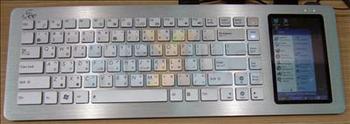It's always fun visiting ASUS at any international trade show, and the Taiwanese outfit's booth at COMPUTEX '09 was no exception.
Packed full of various hardware - including an impressive Eee Top all-in-one, stunning ultra-thin notebooks and monstrous graphics cards - there's literally something for everyone.
What's surprised us, however, is the lack of COMPUTEX enthusiasm for the Eee Keyboard that wowed the crowds at CeBIT just a few months ago.
The Eee Keyboard, pictured above, houses an entire PC in its shell and squeezes in a 5in toushcreen display for good measure. It once sounded marvellous, and now that it's edging closer to retail - perhaps by the end of the month - it appears to be losing some of its momentum.
Inside the 145mm x 425mm x 19mm frame, there's Intel's improved Atom N280 processor, a 1.6GHz part that features a 667MHz front side bus - up from 533MHz on the older Atom N270. So far so good, but the chip is sadly paired with the ageing 945GSE chipset - as opposed to the newer GN40. A cost-cutting measure, perhaps.
Elsewhere, there's 1GB of DDR2 memory, a 16GB or 32GB solid state drive, Wireless N, Ethernet and Bluetooth connectivity, and a 5in touchscreen display that provides an 800x480 resolution. ASUS has even found room to squeeze in stereo speakers and a high-quality mic.
The problem, we reckon, is that Atom-powered netbooks have evolved and the Eee Keyboard now feels like yesterday's product. With NVIDIA's ION now providing full-HD playback and Intel's own PineView on course to ship later this year, the Eee Keyboard's shortcomings are becoming increasingly apparent.
During our hands-on time at COMPUTEX, we found the unit's finish to be exceptional but the cramped 5in touchscreen left something to be desired - perhaps due to the cumbersome and touch-unfriendly Windows XP operating system lying beneath. Whilst fairly snappy in use, we're concerned that the Eee Keyboard may struggle to playback 720p media, and 1080p should be out of the question - that alone limits its capacity as a HTPC.
Our biggest concern, however, is that ASUS quotes the wireless model's battery life to be in the region of a lowly 1.5 hours. We still love the concept, but the Eee Keyboard may not fulfil its potential until the next wave of hardware, we reckon. Looking ahead, a PineView-based system may be better suited, or, dare we sat it, NVIDIA's Tegra.








